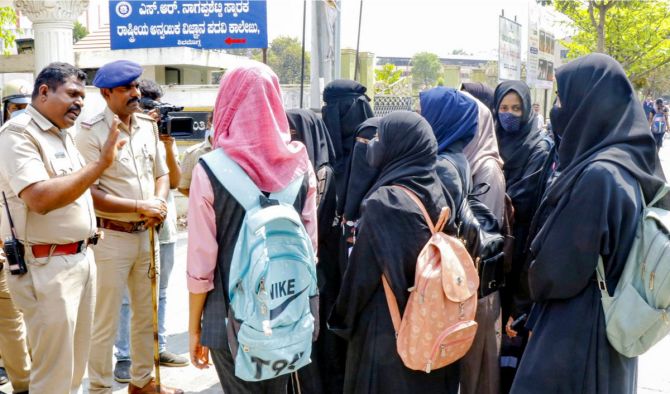 | « Back to article | Print this article |
The best thing we can pray for is that the courts give a quick judgment in favour of Fundamental Rights so that the government can worry about other things than what it will not let young women wear, hopes Aakar Patel.

Yet another issue of fundamental rights of individuals versus the rights of the State has reached the Supreme Court.
As is almost routine in our time, it concerns the minorities.
At issue is whether Article 25 allows the government some room to prohibit the wearing of a headscarf.
The Article reads: 'Subject to public order, morality and health and to the other provisions of this Part, all persons are equally entitled to freedom of conscience and the right freely to profess, practise and propagate religion.'
The straightforward reading of this is that individual rights must be given primacy.
The young women say that covering their head is a religious practice for them and the Constitution guarantees them this as a Fundamental Right.
But the State as it has always done, insists that it has the greater say in what individuals can and cannot do.
One hopes the judiciary sees otherwise, but the record has not been good and most often the justice system backs the State.
For this reason Indians have freedoms on paper that they cannot really exercise in reality.
Even Fundamental Rights, which are supposed to enjoy a high degree of freedom from encroachment by the State, are undermined regularly.
For instance, Indians have the right to freedom of expression, but the State has multiple laws which criminalise free speech.
There is no real freedom of peaceful assembly or freedom of association and both have been criminalised also.
Constitutionally, the freedom of occupation and practising any profession exists but when butchers moved court against cow slaughter laws, the Supreme Court admitted that it had to take religious sentiments into consideration and curtailed the rights.
Again, Christians asked for and were given the right to propagate their religion (the subcontinent's Muslims do not proselytise, but Christians do).
But this right was taken away from them through laws and today propagation is a crime.
The hijab issue has again brought what India is doing to its minorities to the notice of the world.
The United States ambassador at large for international religious freedom tweeted last Friday that 'Religious freedom includes the ability to choose one's religious attire. The Indian state of Karnataka should not determine permissibility of religious clothing. Hijab bans in schools violate religious freedom and stigmatize and marginalize women and girls.'
One hopes that this wise counsel is taken but it is unlikely to be.
The judiciary wants to determine whether hijab is 'essential religious practice' or not.
It has previously told Indian Muslims, as part of the Ayodhya hearings, that mosques are not essential to their religion.
There is a political and social angle also to the current matter, other than the religious one.
I do not claim to speak for the young women, but they are being bullied as part of a systematic campaign against Muslims in India.
They are being blocked from praying at sites allocated to them by the government to being blocked from cooking meat or sent to jail for selling bangles.
The laws that have been passed against them on the issue of citizenship and in Kashmir are all also recent.
It is likely that the young women are standing up for more than just their own rights.
They are standing up for their faith and their community and that is why that one young woman stood up to that ugly mob in those famous visuals that should shame all Indians but will not.
So the question then is, if this is the motivation they are coming from, if they are asked to give up their scarves and hijab, what happens next.
Already the indication is clear.
On Friday, CNN had a headline which said: 'Hijab protests spread in India as girls refuse to be told what not to wear'.
The women will continue to come wearing a headscarf and the State will then have to decide whether or not it wants to use force on them and whether it is sensible to deny them education and entry into examination halls.
It is not difficult to predict this and we have seen what happens when large numbers of citizens stand up to laws that they think are unjust.
The government has to back down as it did in the matter of both the citizenship laws (which were passed but have not been implemented) and the farm laws which were withdrawn.
In both instances, the courts were not sympathetic to the protestors, but that did not matter.
One suspects that something similar will happen here and it is hard to see any other outcome except one in which the State again folds and lets the young women exercise their freedom.
I hope this happens without friction and without a standoff.
The best thing we can pray for is that the courts give a quick judgment in favour of Fundamental Rights so that the government can worry about other things than what it will not let young women wear.
Aakar Patel is a columnist and writer and you can read Aakar's earlier columns here.
Feature Presentation: Aslam Hunani/Rediff.com